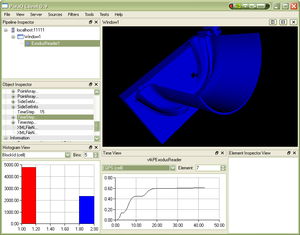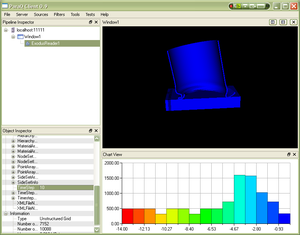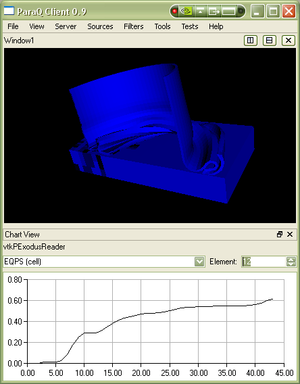ClientSideData
From ParaQ Wiki
Jump to navigationJump to search
Requirements
- Support general-purpose collection of complete data sets from one-to-many parallel servers to the client.
- Support collection of time-varying data from one-to-many parallel servers to the client, e.g: retrieve the value at a specific point/cell over time.
- For scalability, support special-purpose collection of data subsets from one-to-many parallel servers to the client. Examples include plotting graphs, where only a subset of a data object needs to be transmitted to the client for display. See Plotting Parallel Data (PGraph).
Design
- For transferring an entire vtkDataSet from servers to client, a single new proxy type can be created, based on the existing vtkMPIMoveData.
- Collecting time-varying data is more challenging - alternative approaches include:
- Execute the visualization network at regular intervals, sampling the data-of-interest at each time step, then plot the accumulated results. This is the approach used by the ParaView "Probe" and "Pick" filters for plotting. Pros: works today, capable of "recording" any data that varies over time - regardless of network complexity. Cons: extremely poor performance.
- Use "out-of-band" APIs to collect time-varying data from network nodes that support doing so. The (only known?) example of this is vtkExodusReader / vtkPExodusReader, for which the GetTimeSeriesData() method will return an array of values for a given variable and element ID. Pros: works today (on the client), good performance. Cons: usable only with those nodes that implement an API for reading time-varying data. Cannot collect time-varying data that has been modified by filters, without adding the out-of-band API to each filter.
- Expand the visualization pipeline to include time-varying data. Pros: good performance, capable of returning any data that varies, regardless of network complexity. Cons: major changes to VTK pipeline. Passing time-varying data down the pipeline continuously would be a major performance problem, implying that some way of "querying" for data up the pipeline would be necessary, e.g. growing "extents" to support temporal extents. See Time Support for more details on this approach.
Implementation
- A new class, vtkSMClientSideDataProxy, has been created for general-purpose work: it collects a complete vtkDataSet from the servers. To use it, use the AddInput() method to connect it to a source proxy, then call GetCollectedData() to return a vtkDataSet. Internally, it uses vtkMPIMoveData to handle the transfer of data from server(s) to client.
Examples
| ParaQ client displaying both histogram and cell data versus time charts for a data set. | |
| An example of client side data in action: the histogram in this screenshot was generated directly from the vtkDataSet transmitted to the client. | |
| Sample plot of cell data varying over time, for a specified cell (note that in this example the client is querying the client-side Exodus reader directly, so this isn't a true example of transferring data from server(s) to client). |


